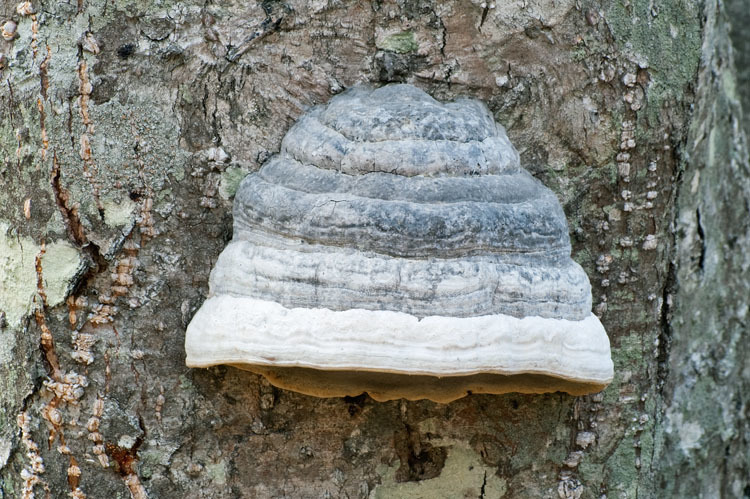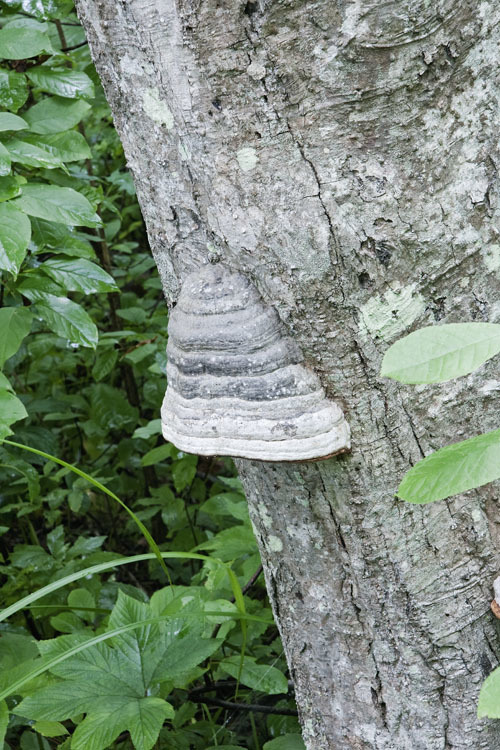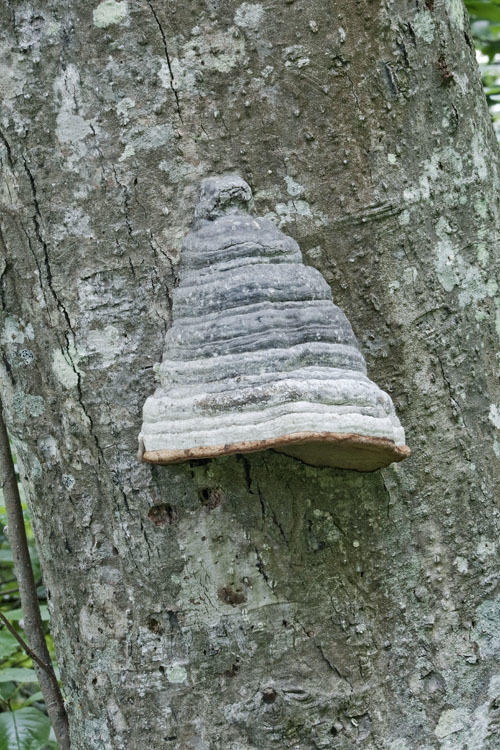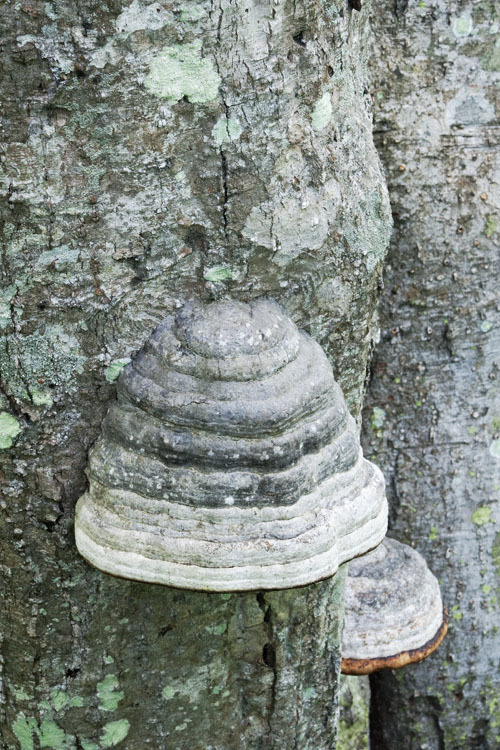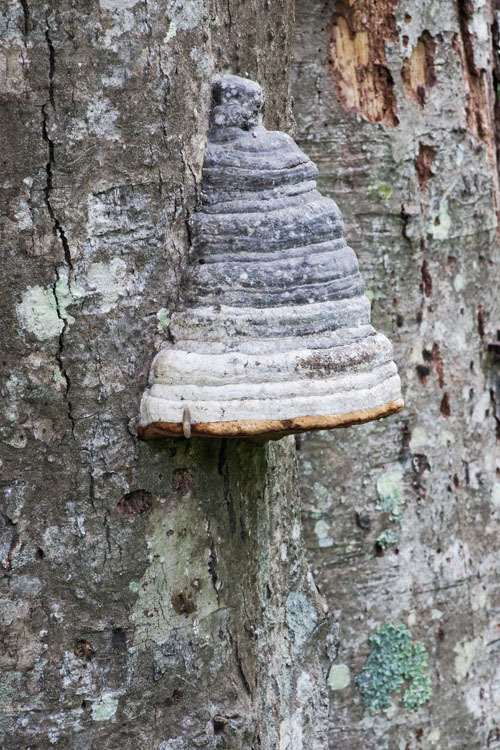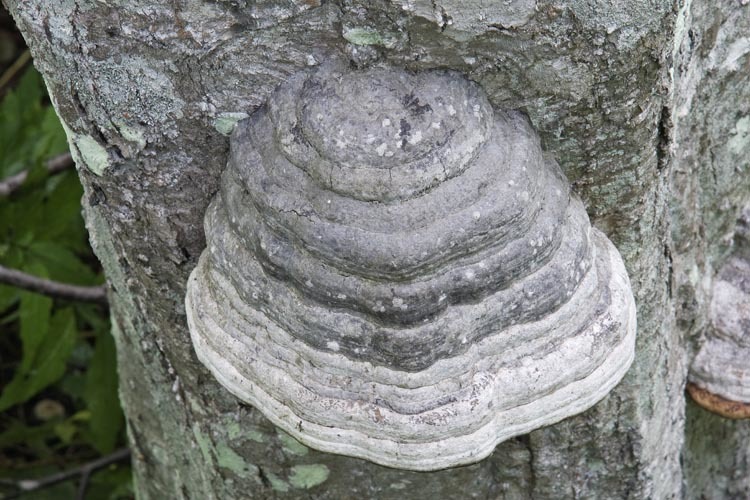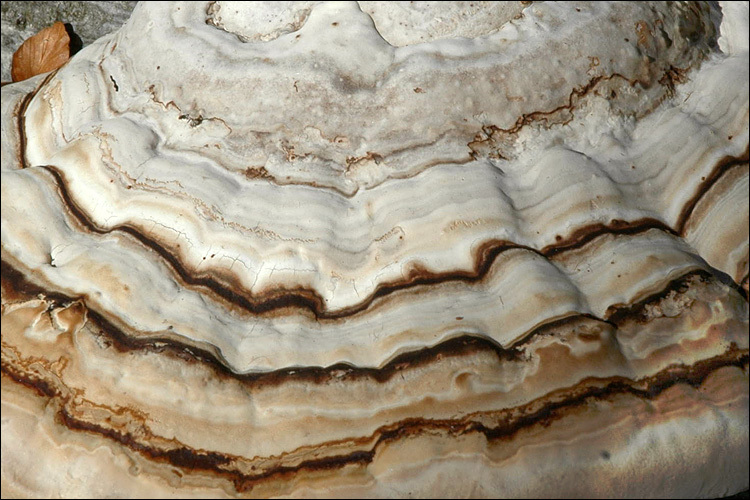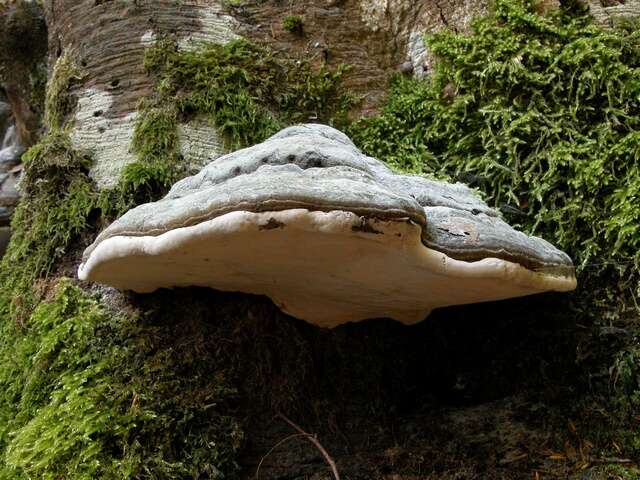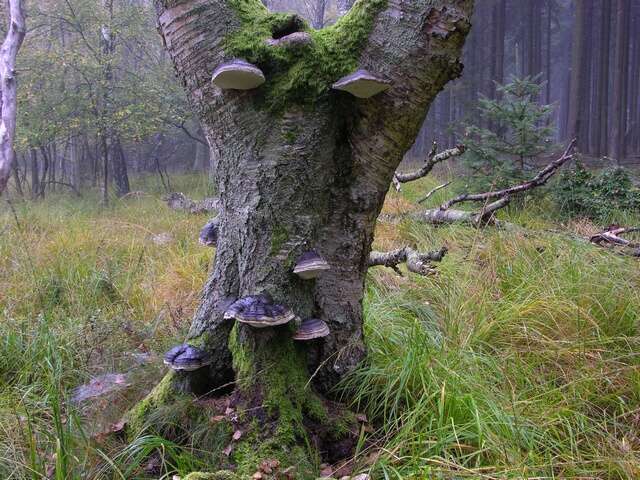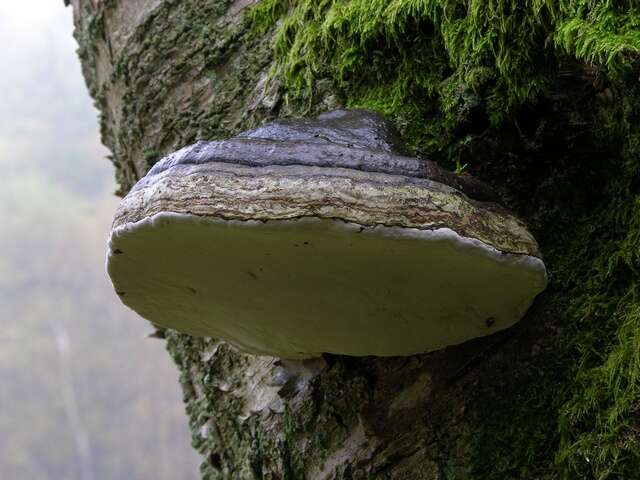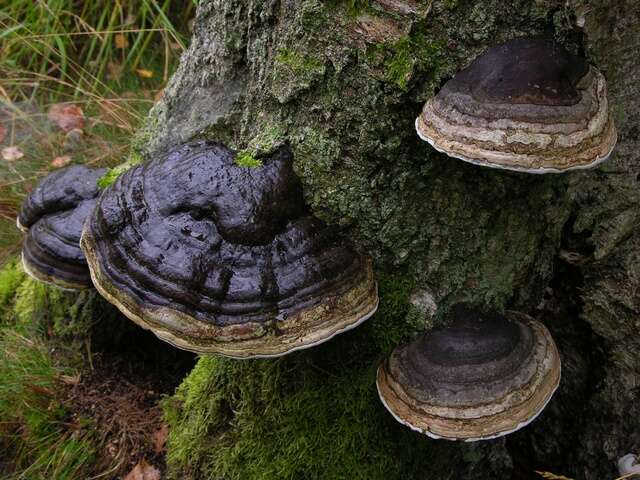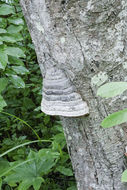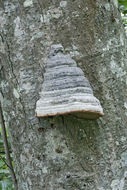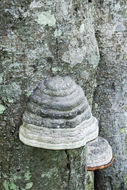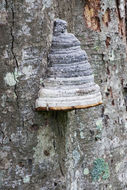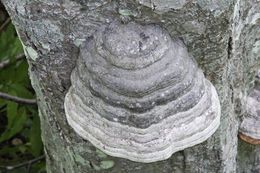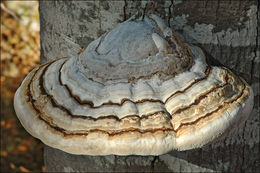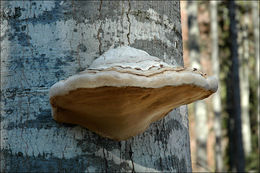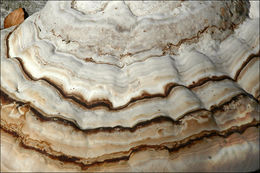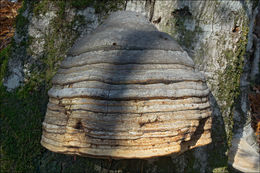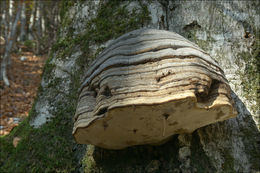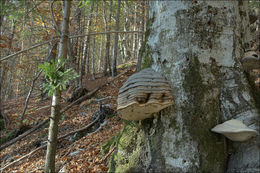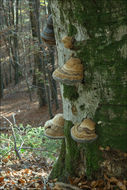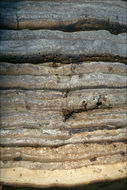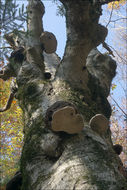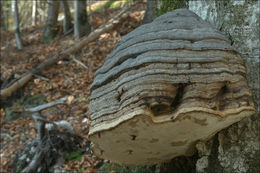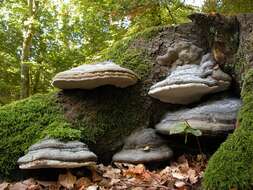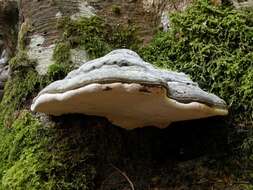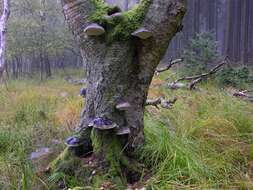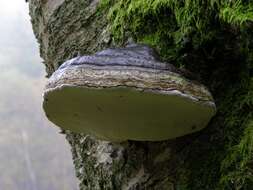-
Also called tinder fungus, touchwood, punk and amaden. Another scientific name is Ungulina fomentaria.
-
Also called tinder fungus, touchwood, punk and amaden. Another scientific name is Ungulina fomentaria.
-
Also called tinder fungus, touchwood, punk and amaden. Another scientific name is Ungulina fomentaria.
-
Also called tinder fungus, touchwood, punk and amaden. Another scientific name is Ungulina fomentaria.
-
Also called tinder fungus, touchwood, punk and amaden. Another scientific name is Ungulina fomentaria.
-
Also called tinder fungus, touchwood, punk and amaden. Another scientific name is Ungulina fomentaria.
-
Slo.: kresilna goba
-
Slo.: kresilna goba
-
Slo.: kresilna goba
-
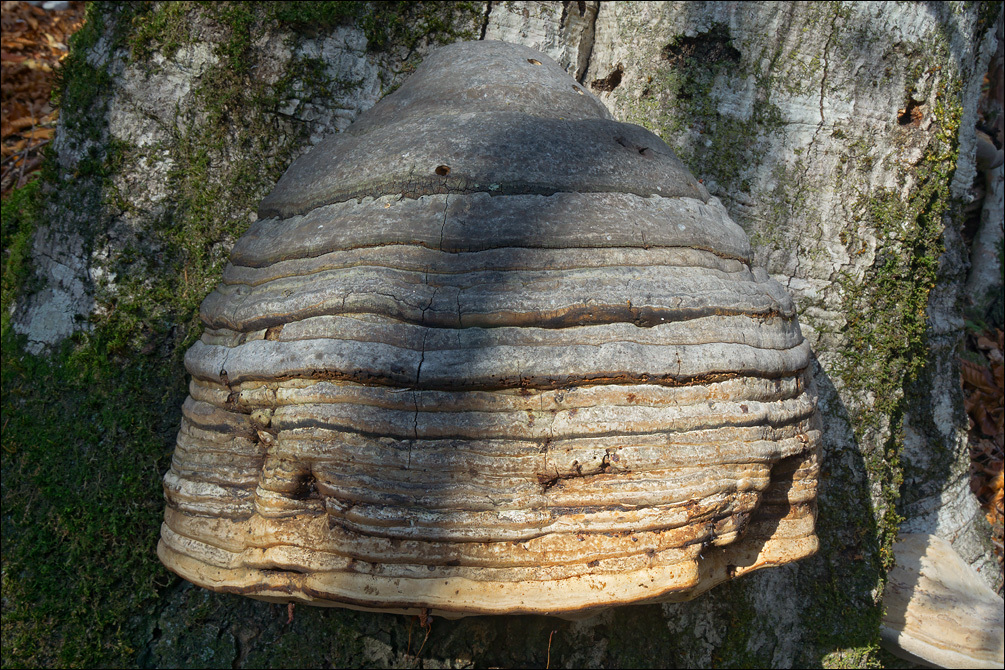
Slo.: kresilna goba - syn.: Pyropolyporus fomentarius (L.) Teng, Ungulina fomentaria (L.) Pat., Polyporus fomentarius (L.) Fr. - Habitat: steep mountain slope, south aspect; mixed wood, Fagus sylvatica, Picea abies, Fraxinus ornus and Ostrya carpinifolia dominant trees; calcareous ground; relatively warm and dry place; average precipitations ~ 3.000 mm/year, average temperature 7-9 deg C, elevation 685 m (2.250 feet), alpine phytogeographical region.Substratum: dead, still standing Fagus sylvatica.Place: Lower Trenta valley, right bank of river Soa; between villages Soa and Trenta; Pod Stemerico place, above Trenta 2b cottage, East Julian Alps, Posoje, Slovenia EC.Comments: Fomes fomentarius is probably the most common and easy to spot Polyporaceae in the Trenta valley and surrounding valleys. Only Fomitopsis pinicola living on dead Picea abies is eventually more frequent and also more noticeable with its orange-red rim of the pilei. This is so because deteriorated and rotten Picea abies trees and trunks are in abundance here. Namely, Picea abies is not really a 'suitable' species for this habitat and climate and hardly thrives bountifully in this region. Also, many trees now grow on former pastures, now abandoned for decades, which were covered with only a very thin layer of soil. Combined with their shallow root system they are almost regularly toppled by strong winds when they become a few decades old. Presence of many dead Picea abies trunks here around is a stage of natural forest succession process. This conifer is gradually replaced by Fagus sylvatica trees, which is a species truly 'at home' in Trenta valley.Fomes fomentarius is mostly easy to recognize as such when it has its typical pileate or hoof-shaped habit. Although, it may cases it looks quite different from most pictures in the books. The habit depends on substratum, position on it and particularly on the age of the sporocarps. When young they are like a roundish 'blobs' of whitish, grayish or yellowish-ocher color, without a pore layer. In the first year pilei are brownish or yellowish, sometimes of reddish tint (ref.: 6) and becoming zonate on upper side. After the first year hard crust develops on the upper sterile side of sporocarps, which becomes gray to brown, and deeply zonate. When old they frequently become hoof-shaped, but other, often bizarre, shapes are also possible. If moist the old sporocarps may look totally black and are frequently difficult to distinguish from old Fomitopsis pinicola pilei. The most characteristic traits of mature Fomes fomentarius are: hard crust on the upper, sterile surface of basidiocarp, and particularly a granular, roundish, dark brown core next to the substratum (seen only in cross section of the sporocarp; a good distinguishing characteristics against sometimes very similar Ganoderma species (Ref:3)), pores with thick tomentose dissepiments and yellowish brown fibrous context. Tube layer is more or less stratified and filled with white mycelium when old. Stratification is often weak (Ref.8.even states: non-stratified tube layer). Basidiocarps are consistently fertile only early in the spring, so there was no spore print with this find. This species is culturally very important. It was found already with 5.500 years old find of frozen body of tzi, also called 'iceman', high in the Alps. He had a piece of Fomes fomentarius sporocarp with him. In men's history the sporocarps had been used as tinder for making and transporting fires for millennia.The sporocarps on the pictures were found on an old, dead Fagus sylvatica tree. There were more than 35 pilei present, from young ones to very old ones. The largest is 37 cm wide, 34 cm high and 22 cm thick! The tree has 2.2 m circumference at about half a meter from ground. SP none.Herbarium: Mycotheca and lichen herbarium (LJU-Li) of Slovenian Forestry Institute, Vena pot 2, Ljubljana, Index Herbariorum LJFRef.: (1) R. Phillips, Mushrooms, Macmillan (2006), p 307.(2) L. Ryvarden, R.L. Gilbertson, European Polypores, Part 1., Synopsis Fungorum 7., Fungiflora A/S (1993), p 254.(3) L. Ryvarden, R.L. I. Melo, Potoid fungi of Europe, Gilbertson, European Polypores, Part 1., Synopsis Fungorum 31., Fungiflora (2014 ), p 178.(4) J. Breitenbach, F. Kraenzlin, Eds., Fungi of Switzerland, Vol.2. Verlag Mykologia (1986), p 306. (5) G.J. Krieglsteiner (Hrsg.), Die Grosspilze Baden-Wrttembergs, Band 1., Ulmer (2000), p 519. (6) A. Bernicchia, Polyporaceaes l., Fungi Europaei, Vol. 10., Edizioni Candusso (2005), p 215.(7) J. Ginns, Polypores of British Columbia, Crown Publ., Technical Report 104 (2017), p 88. (8) D. Arora, Mushrooms Demystified, Ten Speed Press, Berkeley (1986), p 581.
-
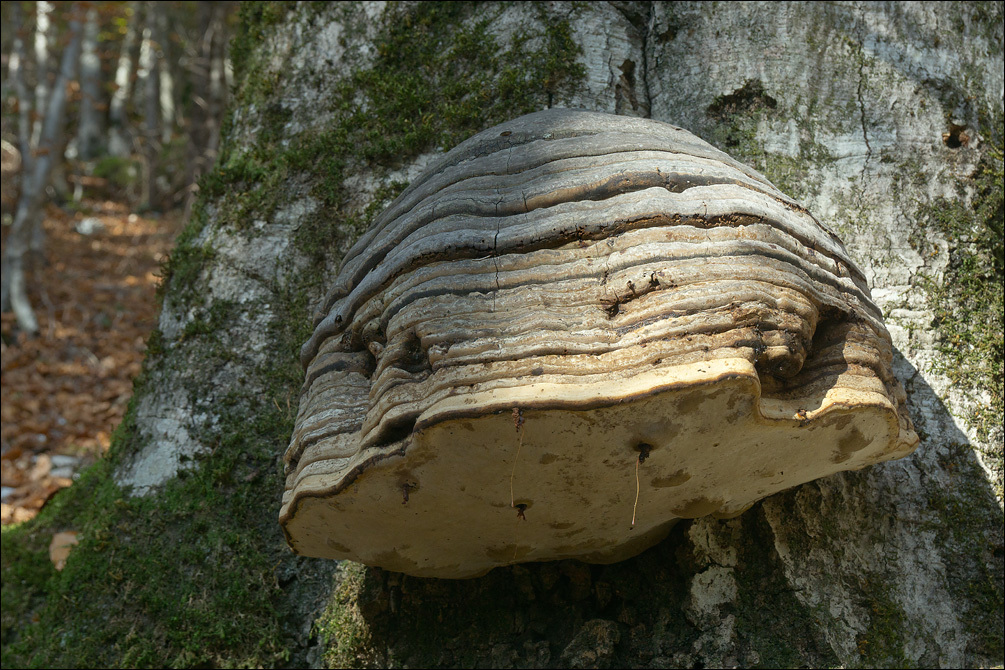
Slo.: kresilna goba - syn.: Pyropolyporus fomentarius (L.) Teng, Ungulina fomentaria (L.) Pat., Polyporus fomentarius (L.) Fr. - Habitat: steep mountain slope, south aspect; mixed wood, Fagus sylvatica, Picea abies, Fraxinus ornus and Ostrya carpinifolia dominant trees; calcareous ground; relatively warm and dry place; average precipitations ~ 3.000 mm/year, average temperature 7-9 deg C, elevation 685 m (2.250 feet), alpine phytogeographical region. Substratum: dead, still standing Fagus sylvatica. Place: Lower Trenta valley, right bank of river Soa; between villages Soa and Trenta; Pod Stemerico place, above Trenta 2b cottage, East Julian Alps, Posoje, Slovenia EC. Comments: Fomes fomentarius is probably the most common and easy to spot Polyporaceae in the Trenta valley and surrounding valleys. Only Fomitopsis pinicola living on dead Picea abies is eventually more frequent and also more noticeable with its orange-red rim of the pilei. This is so because deteriorated and rotten Picea abies trees and trunks are in abundance here. Namely, Picea abies is not really a 'suitable' species for this habitat and climate and hardly thrives bountifully in this region. Also, many trees now grow on former pastures, now abandoned for decades, which were covered with only a very thin layer of soil. Combined with their shallow root system they are almost regularly toppled by strong winds when they become a few decades old. Presence of many dead Picea abies trunks here around is a stage of natural forest succession process. This conifer is gradually replaced by Fagus sylvatica trees, which is a species truly 'at home' in Trenta valley. Fomes fomentarius is mostly easy to recognize as such when it has its typical pileate or hoof-shaped habit. Although, it may cases it looks quite different from most pictures in the books. The habit depends on substratum, position on it and particularly on the age of the sporocarps. When young they are like a roundish 'blobs' of whitish, grayish or yellowish-ocher color, without a pore layer. In the first year pilei are brownish or yellowish, sometimes of reddish tint (ref.: 6) and becoming zonate on upper side. After the first year hard crust develops on the upper sterile side of sporocarps, which becomes gray to brown, and deeply zonate. When old they frequently become hoof-shaped, but other, often bizarre, shapes are also possible. If moist the old sporocarps may look totally black and are frequently difficult to distinguish from old Fomitopsis pinicola pilei. The most characteristic traits of mature Fomes fomentarius are: hard crust on the upper, sterile surface of basidiocarp, and particularly a granular, roundish, dark brown core next to the substratum (seen only in cross section of the sporocarp; a good distinguishing characteristics against sometimes very similar Ganoderma species (Ref:3)), pores with thick tomentose dissepiments and yellowish brown fibrous context. Tube layer is more or less stratified and filled with white mycelium when old. Stratification is often weak (Ref.8.even states: non-stratified tube layer). Basidiocarps are consistently fertile only early in the spring, so there was no spore print with this find. This species is culturally very important. It was found already with 5.500 years old find of frozen body of tzi, also called 'iceman', high in the Alps. He had a piece of Fomes fomentarius sporocarp with him. In men's history the sporocarps had been used as tinder for making and transporting fires for millennia. The sporocarps on the pictures were found on an old, dead Fagus sylvatica tree. There were more than 35 pilei present, from young ones to very old ones. The largest is 37 cm wide, 34 cm high and 22 cm thick! The tree has 2.2 m circumference at about half a meter from ground. SP none. Herbarium: Mycotheca and lichen herbarium (LJU-Li) of Slovenian Forestry Institute, Vena pot 2, Ljubljana, Index Herbariorum LJF Ref.: (1) R. Phillips, Mushrooms, Macmillan (2006), p 307. (2) L. Ryvarden, R.L. Gilbertson, European Polypores, Part 1., Synopsis Fungorum 7., Fungiflora A/S (1993), p 254. (3) L. Ryvarden, R.L. I. Melo, Potoid fungi of Europe, Gilbertson, European Polypores, Part 1., Synopsis Fungorum 31., Fungiflora (2014 ), p 178. (4) J. Breitenbach, F. Kraenzlin, Eds., Fungi of Switzerland, Vol.2. Verlag Mykologia (1986), p 306. (5) G.J. Krieglsteiner (Hrsg.), Die Grosspilze Baden-Wrttembergs, Band 1., Ulmer (2000), p 519. (6) A. Bernicchia, Polyporaceaes l., Fungi Europaei, Vol. 10., Edizioni Candusso (2005), p 215. (7) J. Ginns, Polypores of British Columbia, Crown Publ., Technical Report 104 (2017), p 88. (8) D. Arora, Mushrooms Demystified, Ten Speed Press, Berkeley (1986), p 581.
-

Slo.: kresilna goba - syn.: Pyropolyporus fomentarius (L.) Teng, Ungulina fomentaria (L.) Pat., Polyporus fomentarius (L.) Fr. - Habitat: steep mountain slope, south aspect; mixed wood, Fagus sylvatica, Picea abies, Fraxinus ornus and Ostrya carpinifolia dominant trees; calcareous ground; relatively warm and dry place; average precipitations ~ 3.000 mm/year, average temperature 7-9 deg C, elevation 685 m (2.250 feet), alpine phytogeographical region. Substratum: dead, still standing Fagus sylvatica. Place: Lower Trenta valley, right bank of river Soa; between villages Soa and Trenta; Pod Stemerico place, above Trenta 2b cottage, East Julian Alps, Posoje, Slovenia EC. Comments: Fomes fomentarius is probably the most common and easy to spot Polyporaceae in the Trenta valley and surrounding valleys. Only Fomitopsis pinicola living on dead Picea abies is eventually more frequent and also more noticeable with its orange-red rim of the pilei. This is so because deteriorated and rotten Picea abies trees and trunks are in abundance here. Namely, Picea abies is not really a 'suitable' species for this habitat and climate and hardly thrives bountifully in this region. Also, many trees now grow on former pastures, now abandoned for decades, which were covered with only a very thin layer of soil. Combined with their shallow root system they are almost regularly toppled by strong winds when they become a few decades old. Presence of many dead Picea abies trunks here around is a stage of natural forest succession process. This conifer is gradually replaced by Fagus sylvatica trees, which is a species truly 'at home' in Trenta valley. Fomes fomentarius is mostly easy to recognize as such when it has its typical pileate or hoof-shaped habit. Although, it may cases it looks quite different from most pictures in the books. The habit depends on substratum, position on it and particularly on the age of the sporocarps. When young they are like a roundish 'blobs' of whitish, grayish or yellowish-ocher color, without a pore layer. In the first year pilei are brownish or yellowish, sometimes of reddish tint (ref.: 6) and becoming zonate on upper side. After the first year hard crust develops on the upper sterile side of sporocarps, which becomes gray to brown, and deeply zonate. When old they frequently become hoof-shaped, but other, often bizarre, shapes are also possible. If moist the old sporocarps may look totally black and are frequently difficult to distinguish from old Fomitopsis pinicola pilei. The most characteristic traits of mature Fomes fomentarius are: hard crust on the upper, sterile surface of basidiocarp, and particularly a granular, roundish, dark brown core next to the substratum (seen only in cross section of the sporocarp; a good distinguishing characteristics against sometimes very similar Ganoderma species (Ref:3)), pores with thick tomentose dissepiments and yellowish brown fibrous context. Tube layer is more or less stratified and filled with white mycelium when old. Stratification is often weak (Ref.8.even states: non-stratified tube layer). Basidiocarps are consistently fertile only early in the spring, so there was no spore print with this find. This species is culturally very important. It was found already with 5.500 years old find of frozen body of tzi, also called 'iceman', high in the Alps. He had a piece of Fomes fomentarius sporocarp with him. In men's history the sporocarps had been used as tinder for making and transporting fires for millennia. The sporocarps on the pictures were found on an old, dead Fagus sylvatica tree. There were more than 35 pilei present, from young ones to very old ones. The largest is 37 cm wide, 34 cm high and 22 cm thick! The tree has 2.2 m circumference at about half a meter from ground. SP none. Herbarium: Mycotheca and lichen herbarium (LJU-Li) of Slovenian Forestry Institute, Vena pot 2, Ljubljana, Index Herbariorum LJF Ref.: (1) R. Phillips, Mushrooms, Macmillan (2006), p 307. (2) L. Ryvarden, R.L. Gilbertson, European Polypores, Part 1., Synopsis Fungorum 7., Fungiflora A/S (1993), p 254. (3) L. Ryvarden, R.L. I. Melo, Potoid fungi of Europe, Gilbertson, European Polypores, Part 1., Synopsis Fungorum 31., Fungiflora (2014 ), p 178. (4) J. Breitenbach, F. Kraenzlin, Eds., Fungi of Switzerland, Vol.2. Verlag Mykologia (1986), p 306. (5) G.J. Krieglsteiner (Hrsg.), Die Grosspilze Baden-Wrttembergs, Band 1., Ulmer (2000), p 519. (6) A. Bernicchia, Polyporaceaes l., Fungi Europaei, Vol. 10., Edizioni Candusso (2005), p 215. (7) J. Ginns, Polypores of British Columbia, Crown Publ., Technical Report 104 (2017), p 88. (8) D. Arora, Mushrooms Demystified, Ten Speed Press, Berkeley (1986), p 581.
-
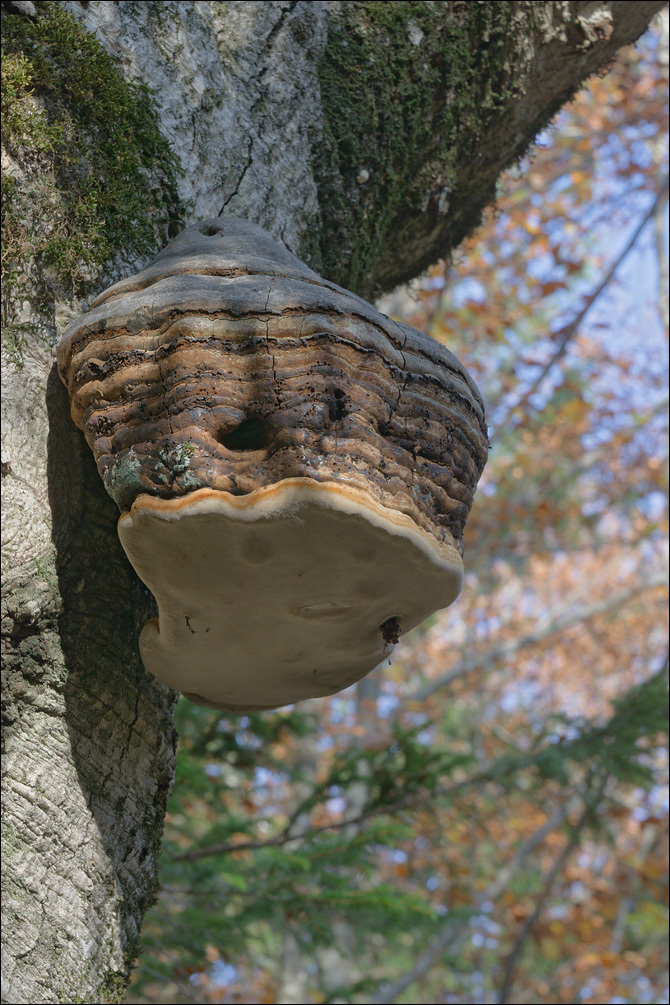
Slo.: kresilna goba - syn.: Pyropolyporus fomentarius (L.) Teng, Ungulina fomentaria (L.) Pat., Polyporus fomentarius (L.) Fr. - Habitat: steep mountain slope, south aspect; mixed wood, Fagus sylvatica, Picea abies, Fraxinus ornus and Ostrya carpinifolia dominant trees; calcareous ground; relatively warm and dry place; average precipitations ~ 3.000 mm/year, average temperature 7-9 deg C, elevation 685 m (2.250 feet), alpine phytogeographical region. Substratum: dead, still standing Fagus sylvatica. Place: Lower Trenta valley, right bank of river Soa; between villages Soa and Trenta; Pod Stemerico place, above Trenta 2b cottage, East Julian Alps, Posoje, Slovenia EC. Comments: Fomes fomentarius is probably the most common and easy to spot Polyporaceae in the Trenta valley and surrounding valleys. Only Fomitopsis pinicola living on dead Picea abies is eventually more frequent and also more noticeable with its orange-red rim of the pilei. This is so because deteriorated and rotten Picea abies trees and trunks are in abundance here. Namely, Picea abies is not really a 'suitable' species for this habitat and climate and hardly thrives bountifully in this region. Also, many trees now grow on former pastures, now abandoned for decades, which were covered with only a very thin layer of soil. Combined with their shallow root system they are almost regularly toppled by strong winds when they become a few decades old. Presence of many dead Picea abies trunks here around is a stage of natural forest succession process. This conifer is gradually replaced by Fagus sylvatica trees, which is a species truly 'at home' in Trenta valley. Fomes fomentarius is mostly easy to recognize as such when it has its typical pileate or hoof-shaped habit. Although, it may cases it looks quite different from most pictures in the books. The habit depends on substratum, position on it and particularly on the age of the sporocarps. When young they are like a roundish 'blobs' of whitish, grayish or yellowish-ocher color, without a pore layer. In the first year pilei are brownish or yellowish, sometimes of reddish tint (ref.: 6) and becoming zonate on upper side. After the first year hard crust develops on the upper sterile side of sporocarps, which becomes gray to brown, and deeply zonate. When old they frequently become hoof-shaped, but other, often bizarre, shapes are also possible. If moist the old sporocarps may look totally black and are frequently difficult to distinguish from old Fomitopsis pinicola pilei. The most characteristic traits of mature Fomes fomentarius are: hard crust on the upper, sterile surface of basidiocarp, and particularly a granular, roundish, dark brown core next to the substratum (seen only in cross section of the sporocarp; a good distinguishing characteristics against sometimes very similar Ganoderma species (Ref:3)), pores with thick tomentose dissepiments and yellowish brown fibrous context. Tube layer is more or less stratified and filled with white mycelium when old. Stratification is often weak (Ref.8.even states: non-stratified tube layer). Basidiocarps are consistently fertile only early in the spring, so there was no spore print with this find. This species is culturally very important. It was found already with 5.500 years old find of frozen body of tzi, also called 'iceman', high in the Alps. He had a piece of Fomes fomentarius sporocarp with him. In men's history the sporocarps had been used as tinder for making and transporting fires for millennia. The sporocarps on the pictures were found on an old, dead Fagus sylvatica tree. There were more than 35 pilei present, from young ones to very old ones. The largest is 37 cm wide, 34 cm high and 22 cm thick! The tree has 2.2 m circumference at about half a meter from ground. SP none. Herbarium: Mycotheca and lichen herbarium (LJU-Li) of Slovenian Forestry Institute, Vena pot 2, Ljubljana, Index Herbariorum LJF Ref.: (1) R. Phillips, Mushrooms, Macmillan (2006), p 307. (2) L. Ryvarden, R.L. Gilbertson, European Polypores, Part 1., Synopsis Fungorum 7., Fungiflora A/S (1993), p 254. (3) L. Ryvarden, R.L. I. Melo, Potoid fungi of Europe, Gilbertson, European Polypores, Part 1., Synopsis Fungorum 31., Fungiflora (2014 ), p 178. (4) J. Breitenbach, F. Kraenzlin, Eds., Fungi of Switzerland, Vol.2. Verlag Mykologia (1986), p 306. (5) G.J. Krieglsteiner (Hrsg.), Die Grosspilze Baden-Wrttembergs, Band 1., Ulmer (2000), p 519. (6) A. Bernicchia, Polyporaceaes l., Fungi Europaei, Vol. 10., Edizioni Candusso (2005), p 215. (7) J. Ginns, Polypores of British Columbia, Crown Publ., Technical Report 104 (2017), p 88. (8) D. Arora, Mushrooms Demystified, Ten Speed Press, Berkeley (1986), p 581.
-

Slo.: kresilna goba - syn.: Pyropolyporus fomentarius (L.) Teng, Ungulina fomentaria (L.) Pat., Polyporus fomentarius (L.) Fr. - Habitat: steep mountain slope, south aspect; mixed wood, Fagus sylvatica, Picea abies, Fraxinus ornus and Ostrya carpinifolia dominant trees; calcareous ground; relatively warm and dry place; average precipitations ~ 3.000 mm/year, average temperature 7-9 deg C, elevation 685 m (2.250 feet), alpine phytogeographical region. Substratum: dead, still standing Fagus sylvatica. Place: Lower Trenta valley, right bank of river Soa; between villages Soa and Trenta; Pod Stemerico place, above Trenta 2b cottage, East Julian Alps, Posoje, Slovenia EC. Comments: Fomes fomentarius is probably the most common and easy to spot Polyporaceae in the Trenta valley and surrounding valleys. Only Fomitopsis pinicola living on dead Picea abies is eventually more frequent and also more noticeable with its orange-red rim of the pilei. This is so because deteriorated and rotten Picea abies trees and trunks are in abundance here. Namely, Picea abies is not really a 'suitable' species for this habitat and climate and hardly thrives bountifully in this region. Also, many trees now grow on former pastures, now abandoned for decades, which were covered with only a very thin layer of soil. Combined with their shallow root system they are almost regularly toppled by strong winds when they become a few decades old. Presence of many dead Picea abies trunks here around is a stage of natural forest succession process. This conifer is gradually replaced by Fagus sylvatica trees, which is a species truly 'at home' in Trenta valley. Fomes fomentarius is mostly easy to recognize as such when it has its typical pileate or hoof-shaped habit. Although, it may cases it looks quite different from most pictures in the books. The habit depends on substratum, position on it and particularly on the age of the sporocarps. When young they are like a roundish 'blobs' of whitish, grayish or yellowish-ocher color, without a pore layer. In the first year pilei are brownish or yellowish, sometimes of reddish tint (ref.: 6) and becoming zonate on upper side. After the first year hard crust develops on the upper sterile side of sporocarps, which becomes gray to brown, and deeply zonate. When old they frequently become hoof-shaped, but other, often bizarre, shapes are also possible. If moist the old sporocarps may look totally black and are frequently difficult to distinguish from old Fomitopsis pinicola pilei. The most characteristic traits of mature Fomes fomentarius are: hard crust on the upper, sterile surface of basidiocarp, and particularly a granular, roundish, dark brown core next to the substratum (seen only in cross section of the sporocarp; a good distinguishing characteristics against sometimes very similar Ganoderma species (Ref:3)), pores with thick tomentose dissepiments and yellowish brown fibrous context. Tube layer is more or less stratified and filled with white mycelium when old. Stratification is often weak (Ref.8.even states: non-stratified tube layer). Basidiocarps are consistently fertile only early in the spring, so there was no spore print with this find. This species is culturally very important. It was found already with 5.500 years old find of frozen body of tzi, also called 'iceman', high in the Alps. He had a piece of Fomes fomentarius sporocarp with him. In men's history the sporocarps had been used as tinder for making and transporting fires for millennia. The sporocarps on the pictures were found on an old, dead Fagus sylvatica tree. There were more than 35 pilei present, from young ones to very old ones. The largest is 37 cm wide, 34 cm high and 22 cm thick! The tree has 2.2 m circumference at about half a meter from ground. SP none. Herbarium: Mycotheca and lichen herbarium (LJU-Li) of Slovenian Forestry Institute, Vena pot 2, Ljubljana, Index Herbariorum LJF Ref.: (1) R. Phillips, Mushrooms, Macmillan (2006), p 307. (2) L. Ryvarden, R.L. Gilbertson, European Polypores, Part 1., Synopsis Fungorum 7., Fungiflora A/S (1993), p 254. (3) L. Ryvarden, R.L. I. Melo, Potoid fungi of Europe, Gilbertson, European Polypores, Part 1., Synopsis Fungorum 31., Fungiflora (2014 ), p 178. (4) J. Breitenbach, F. Kraenzlin, Eds., Fungi of Switzerland, Vol.2. Verlag Mykologia (1986), p 306. (5) G.J. Krieglsteiner (Hrsg.), Die Grosspilze Baden-Wrttembergs, Band 1., Ulmer (2000), p 519. (6) A. Bernicchia, Polyporaceaes l., Fungi Europaei, Vol. 10., Edizioni Candusso (2005), p 215. (7) J. Ginns, Polypores of British Columbia, Crown Publ., Technical Report 104 (2017), p 88. (8) D. Arora, Mushrooms Demystified, Ten Speed Press, Berkeley (1986), p 581.
-
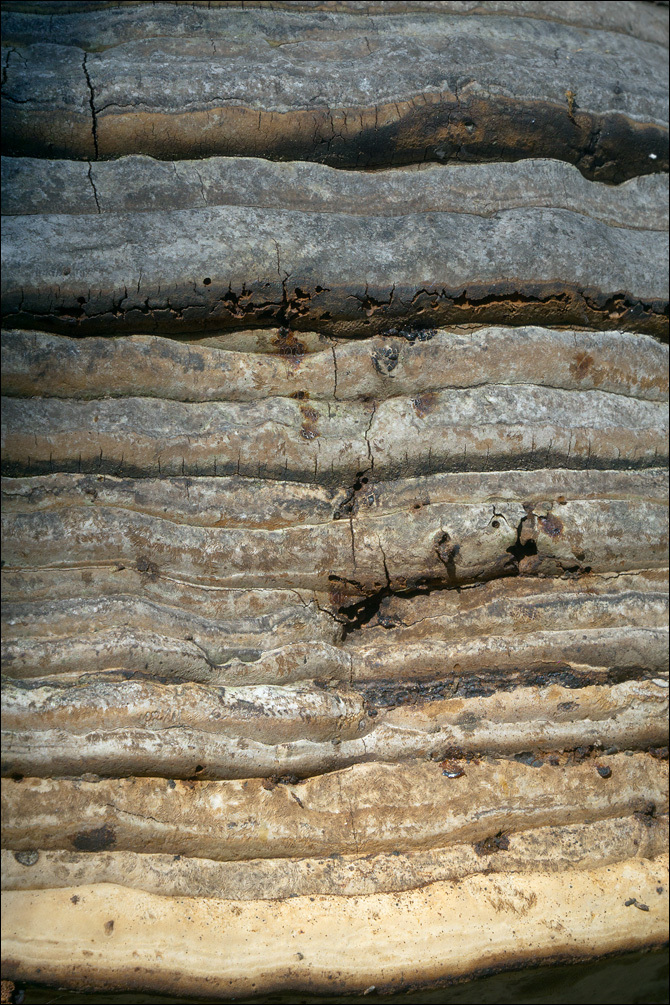
Slo.: kresilna goba - syn.: Pyropolyporus fomentarius (L.) Teng, Ungulina fomentaria (L.) Pat., Polyporus fomentarius (L.) Fr. - Habitat: steep mountain slope, south aspect; mixed wood, Fagus sylvatica, Picea abies, Fraxinus ornus and Ostrya carpinifolia dominant trees; calcareous ground; relatively warm and dry place; average precipitations ~ 3.000 mm/year, average temperature 7-9 deg C, elevation 685 m (2.250 feet), alpine phytogeographical region. Substratum: dead, still standing Fagus sylvatica. Place: Lower Trenta valley, right bank of river Soa; between villages Soa and Trenta; Pod Stemerico place, above Trenta 2b cottage, East Julian Alps, Posoje, Slovenia EC. Comments: Fomes fomentarius is probably the most common and easy to spot Polyporaceae in the Trenta valley and surrounding valleys. Only Fomitopsis pinicola living on dead Picea abies is eventually more frequent and also more noticeable with its orange-red rim of the pilei. This is so because deteriorated and rotten Picea abies trees and trunks are in abundance here. Namely, Picea abies is not really a 'suitable' species for this habitat and climate and hardly thrives bountifully in this region. Also, many trees now grow on former pastures, now abandoned for decades, which were covered with only a very thin layer of soil. Combined with their shallow root system they are almost regularly toppled by strong winds when they become a few decades old. Presence of many dead Picea abies trunks here around is a stage of natural forest succession process. This conifer is gradually replaced by Fagus sylvatica trees, which is a species truly 'at home' in Trenta valley. Fomes fomentarius is mostly easy to recognize as such when it has its typical pileate or hoof-shaped habit. Although, it may cases it looks quite different from most pictures in the books. The habit depends on substratum, position on it and particularly on the age of the sporocarps. When young they are like a roundish 'blobs' of whitish, grayish or yellowish-ocher color, without a pore layer. In the first year pilei are brownish or yellowish, sometimes of reddish tint (ref.: 6) and becoming zonate on upper side. After the first year hard crust develops on the upper sterile side of sporocarps, which becomes gray to brown, and deeply zonate. When old they frequently become hoof-shaped, but other, often bizarre, shapes are also possible. If moist the old sporocarps may look totally black and are frequently difficult to distinguish from old Fomitopsis pinicola pilei. The most characteristic traits of mature Fomes fomentarius are: hard crust on the upper, sterile surface of basidiocarp, and particularly a granular, roundish, dark brown core next to the substratum (seen only in cross section of the sporocarp; a good distinguishing characteristics against sometimes very similar Ganoderma species (Ref:3)), pores with thick tomentose dissepiments and yellowish brown fibrous context. Tube layer is more or less stratified and filled with white mycelium when old. Stratification is often weak (Ref.8.even states: non-stratified tube layer). Basidiocarps are consistently fertile only early in the spring, so there was no spore print with this find. This species is culturally very important. It was found already with 5.500 years old find of frozen body of tzi, also called 'iceman', high in the Alps. He had a piece of Fomes fomentarius sporocarp with him. In men's history the sporocarps had been used as tinder for making and transporting fires for millennia. The sporocarps on the pictures were found on an old, dead Fagus sylvatica tree. There were more than 35 pilei present, from young ones to very old ones. The largest is 37 cm wide, 34 cm high and 22 cm thick! The tree has 2.2 m circumference at about half a meter from ground. SP none. Herbarium: Mycotheca and lichen herbarium (LJU-Li) of Slovenian Forestry Institute, Vena pot 2, Ljubljana, Index Herbariorum LJF Ref.: (1) R. Phillips, Mushrooms, Macmillan (2006), p 307. (2) L. Ryvarden, R.L. Gilbertson, European Polypores, Part 1., Synopsis Fungorum 7., Fungiflora A/S (1993), p 254. (3) L. Ryvarden, R.L. I. Melo, Potoid fungi of Europe, Gilbertson, European Polypores, Part 1., Synopsis Fungorum 31., Fungiflora (2014 ), p 178. (4) J. Breitenbach, F. Kraenzlin, Eds., Fungi of Switzerland, Vol.2. Verlag Mykologia (1986), p 306. (5) G.J. Krieglsteiner (Hrsg.), Die Grosspilze Baden-Wrttembergs, Band 1., Ulmer (2000), p 519. (6) A. Bernicchia, Polyporaceaes l., Fungi Europaei, Vol. 10., Edizioni Candusso (2005), p 215. (7) J. Ginns, Polypores of British Columbia, Crown Publ., Technical Report 104 (2017), p 88. (8) D. Arora, Mushrooms Demystified, Ten Speed Press, Berkeley (1986), p 581.
-
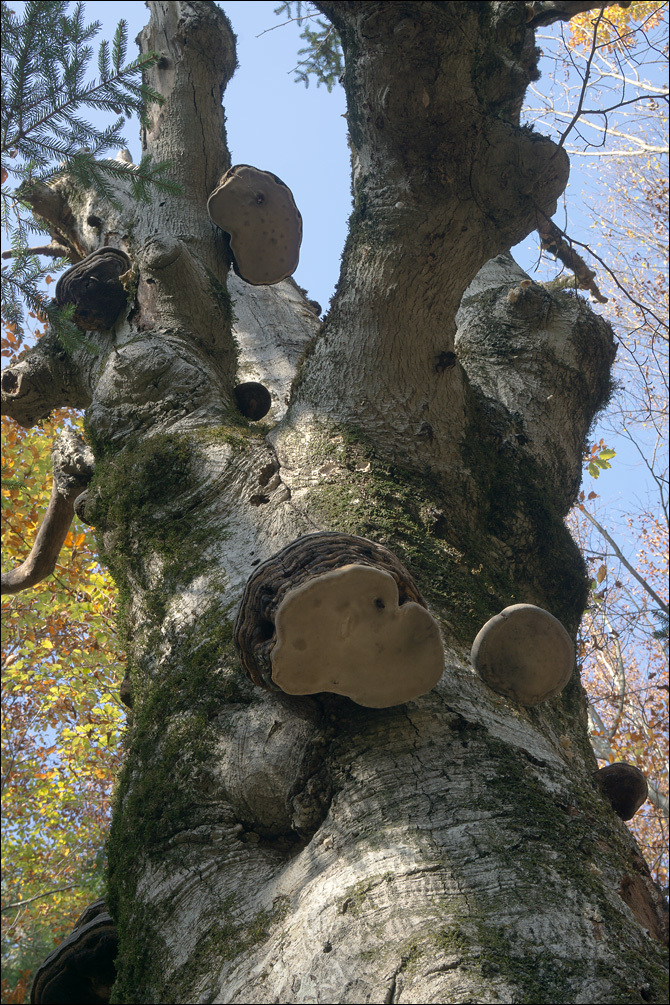
Slo.: kresilna goba - syn.: Pyropolyporus fomentarius (L.) Teng, Ungulina fomentaria (L.) Pat., Polyporus fomentarius (L.) Fr. - Habitat: steep mountain slope, south aspect; mixed wood, Fagus sylvatica, Picea abies, Fraxinus ornus and Ostrya carpinifolia dominant trees; calcareous ground; relatively warm and dry place; average precipitations ~ 3.000 mm/year, average temperature 7-9 deg C, elevation 685 m (2.250 feet), alpine phytogeographical region. Substratum: dead, still standing Fagus sylvatica. Place: Lower Trenta valley, right bank of river Soa; between villages Soa and Trenta; Pod Stemerico place, above Trenta 2b cottage, East Julian Alps, Posoje, Slovenia EC. Comments: Fomes fomentarius is probably the most common and easy to spot Polyporaceae in the Trenta valley and surrounding valleys. Only Fomitopsis pinicola living on dead Picea abies is eventually more frequent and also more noticeable with its orange-red rim of the pilei. This is so because deteriorated and rotten Picea abies trees and trunks are in abundance here. Namely, Picea abies is not really a 'suitable' species for this habitat and climate and hardly thrives bountifully in this region. Also, many trees now grow on former pastures, now abandoned for decades, which were covered with only a very thin layer of soil. Combined with their shallow root system they are almost regularly toppled by strong winds when they become a few decades old. Presence of many dead Picea abies trunks here around is a stage of natural forest succession process. This conifer is gradually replaced by Fagus sylvatica trees, which is a species truly 'at home' in Trenta valley. Fomes fomentarius is mostly easy to recognize as such when it has its typical pileate or hoof-shaped habit. Although, it may cases it looks quite different from most pictures in the books. The habit depends on substratum, position on it and particularly on the age of the sporocarps. When young they are like a roundish 'blobs' of whitish, grayish or yellowish-ocher color, without a pore layer. In the first year pilei are brownish or yellowish, sometimes of reddish tint (ref.: 6) and becoming zonate on upper side. After the first year hard crust develops on the upper sterile side of sporocarps, which becomes gray to brown, and deeply zonate. When old they frequently become hoof-shaped, but other, often bizarre, shapes are also possible. If moist the old sporocarps may look totally black and are frequently difficult to distinguish from old Fomitopsis pinicola pilei. The most characteristic traits of mature Fomes fomentarius are: hard crust on the upper, sterile surface of basidiocarp, and particularly a granular, roundish, dark brown core next to the substratum (seen only in cross section of the sporocarp; a good distinguishing characteristics against sometimes very similar Ganoderma species (Ref:3)), pores with thick tomentose dissepiments and yellowish brown fibrous context. Tube layer is more or less stratified and filled with white mycelium when old. Stratification is often weak (Ref.8.even states: non-stratified tube layer). Basidiocarps are consistently fertile only early in the spring, so there was no spore print with this find. This species is culturally very important. It was found already with 5.500 years old find of frozen body of tzi, also called 'iceman', high in the Alps. He had a piece of Fomes fomentarius sporocarp with him. In men's history the sporocarps had been used as tinder for making and transporting fires for millennia. The sporocarps on the pictures were found on an old, dead Fagus sylvatica tree. There were more than 35 pilei present, from young ones to very old ones. The largest is 37 cm wide, 34 cm high and 22 cm thick! The tree has 2.2 m circumference at about half a meter from ground. SP none. Herbarium: Mycotheca and lichen herbarium (LJU-Li) of Slovenian Forestry Institute, Vena pot 2, Ljubljana, Index Herbariorum LJF Ref.: (1) R. Phillips, Mushrooms, Macmillan (2006), p 307. (2) L. Ryvarden, R.L. Gilbertson, European Polypores, Part 1., Synopsis Fungorum 7., Fungiflora A/S (1993), p 254. (3) L. Ryvarden, R.L. I. Melo, Potoid fungi of Europe, Gilbertson, European Polypores, Part 1., Synopsis Fungorum 31., Fungiflora (2014 ), p 178. (4) J. Breitenbach, F. Kraenzlin, Eds., Fungi of Switzerland, Vol.2. Verlag Mykologia (1986), p 306. (5) G.J. Krieglsteiner (Hrsg.), Die Grosspilze Baden-Wrttembergs, Band 1., Ulmer (2000), p 519. (6) A. Bernicchia, Polyporaceaes l., Fungi Europaei, Vol. 10., Edizioni Candusso (2005), p 215. (7) J. Ginns, Polypores of British Columbia, Crown Publ., Technical Report 104 (2017), p 88. (8) D. Arora, Mushrooms Demystified, Ten Speed Press, Berkeley (1986), p 581.
-
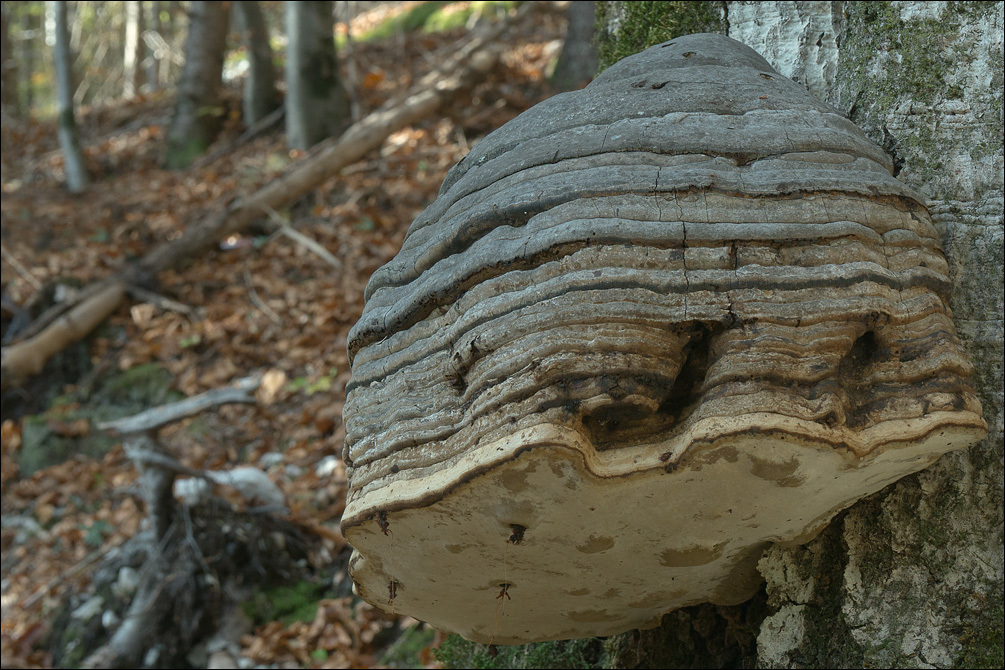
Slo.: kresilna goba - syn.: Pyropolyporus fomentarius (L.) Teng, Ungulina fomentaria (L.) Pat., Polyporus fomentarius (L.) Fr. - Habitat: steep mountain slope, south aspect; mixed wood, Fagus sylvatica, Picea abies, Fraxinus ornus and Ostrya carpinifolia dominant trees; calcareous ground; relatively warm and dry place; average precipitations ~ 3.000 mm/year, average temperature 7-9 deg C, elevation 685 m (2.250 feet), alpine phytogeographical region. Substratum: dead, still standing Fagus sylvatica. Place: Lower Trenta valley, right bank of river Soa; between villages Soa and Trenta; Pod Stemerico place, above Trenta 2b cottage, East Julian Alps, Posoje, Slovenia EC. Comments: Fomes fomentarius is probably the most common and easy to spot Polyporaceae in the Trenta valley and surrounding valleys. Only Fomitopsis pinicola living on dead Picea abies is eventually more frequent and also more noticeable with its orange-red rim of the pilei. This is so because deteriorated and rotten Picea abies trees and trunks are in abundance here. Namely, Picea abies is not really a 'suitable' species for this habitat and climate and hardly thrives bountifully in this region. Also, many trees now grow on former pastures, now abandoned for decades, which were covered with only a very thin layer of soil. Combined with their shallow root system they are almost regularly toppled by strong winds when they become a few decades old. Presence of many dead Picea abies trunks here around is a stage of natural forest succession process. This conifer is gradually replaced by Fagus sylvatica trees, which is a species truly 'at home' in Trenta valley. Fomes fomentarius is mostly easy to recognize as such when it has its typical pileate or hoof-shaped habit. Although, it may cases it looks quite different from most pictures in the books. The habit depends on substratum, position on it and particularly on the age of the sporocarps. When young they are like a roundish 'blobs' of whitish, grayish or yellowish-ocher color, without a pore layer. In the first year pilei are brownish or yellowish, sometimes of reddish tint (ref.: 6) and becoming zonate on upper side. After the first year hard crust develops on the upper sterile side of sporocarps, which becomes gray to brown, and deeply zonate. When old they frequently become hoof-shaped, but other, often bizarre, shapes are also possible. If moist the old sporocarps may look totally black and are frequently difficult to distinguish from old Fomitopsis pinicola pilei. The most characteristic traits of mature Fomes fomentarius are: hard crust on the upper, sterile surface of basidiocarp, and particularly a granular, roundish, dark brown core next to the substratum (seen only in cross section of the sporocarp; a good distinguishing characteristics against sometimes very similar Ganoderma species (Ref:3)), pores with thick tomentose dissepiments and yellowish brown fibrous context. Tube layer is more or less stratified and filled with white mycelium when old. Stratification is often weak (Ref.8.even states: non-stratified tube layer). Basidiocarps are consistently fertile only early in the spring, so there was no spore print with this find. This species is culturally very important. It was found already with 5.500 years old find of frozen body of tzi, also called 'iceman', high in the Alps. He had a piece of Fomes fomentarius sporocarp with him. In men's history the sporocarps had been used as tinder for making and transporting fires for millennia. The sporocarps on the pictures were found on an old, dead Fagus sylvatica tree. There were more than 35 pilei present, from young ones to very old ones. The largest is 37 cm wide, 34 cm high and 22 cm thick! The tree has 2.2 m circumference at about half a meter from ground. SP none. Herbarium: Mycotheca and lichen herbarium (LJU-Li) of Slovenian Forestry Institute, Vena pot 2, Ljubljana, Index Herbariorum LJF Ref.: (1) R. Phillips, Mushrooms, Macmillan (2006), p 307. (2) L. Ryvarden, R.L. Gilbertson, European Polypores, Part 1., Synopsis Fungorum 7., Fungiflora A/S (1993), p 254. (3) L. Ryvarden, R.L. I. Melo, Potoid fungi of Europe, Gilbertson, European Polypores, Part 1., Synopsis Fungorum 31., Fungiflora (2014 ), p 178. (4) J. Breitenbach, F. Kraenzlin, Eds., Fungi of Switzerland, Vol.2. Verlag Mykologia (1986), p 306. (5) G.J. Krieglsteiner (Hrsg.), Die Grosspilze Baden-Wrttembergs, Band 1., Ulmer (2000), p 519. (6) A. Bernicchia, Polyporaceaes l., Fungi Europaei, Vol. 10., Edizioni Candusso (2005), p 215. (7) J. Ginns, Polypores of British Columbia, Crown Publ., Technical Report 104 (2017), p 88. (8) D. Arora, Mushrooms Demystified, Ten Speed Press, Berkeley (1986), p 581.
-
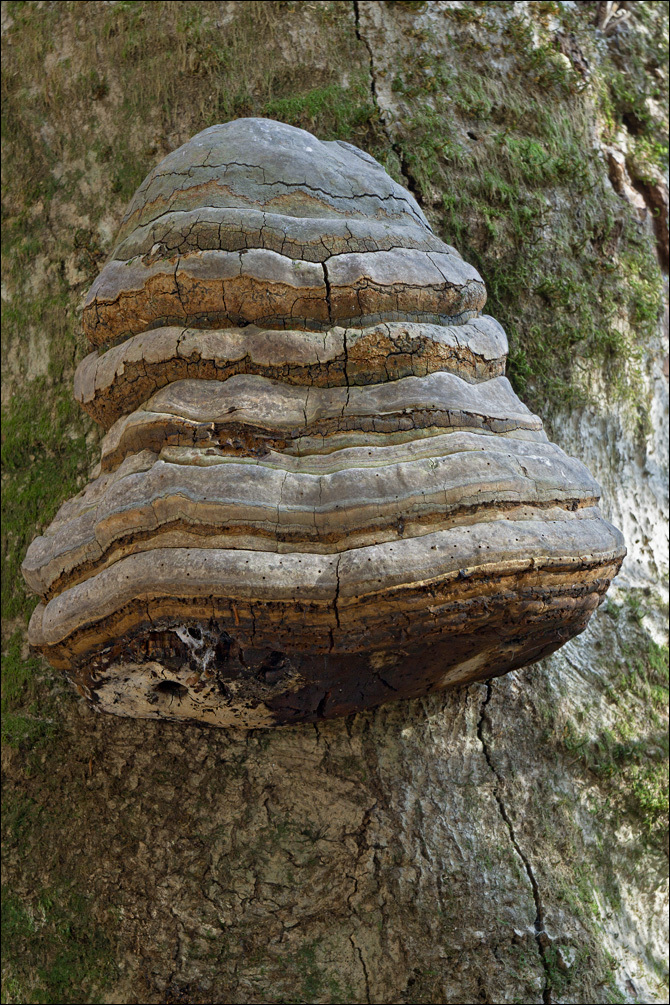
Slo.: kresilna goba - syn.: Pyropolyporus fomentarius (L.) Teng, Ungulina fomentaria (L.) Pat., Polyporus fomentarius (L.) Fr. - Habitat: steep mountain slope, south aspect; mixed wood, Fagus sylvatica, Picea abies, Fraxinus ornus and Ostrya carpinifolia dominant trees; calcareous ground; relatively warm and dry place; average precipitations ~ 3.000 mm/year, average temperature 7-9 deg C, elevation 685 m (2.250 feet), alpine phytogeographical region. Substratum: dead, still standing Fagus sylvatica. Place: Lower Trenta valley, right bank of river Soa; between villages Soa and Trenta; Pod Stemerico place, above Trenta 2b cottage, East Julian Alps, Posoje, Slovenia EC. Comments: Fomes fomentarius is probably the most common and easy to spot Polyporaceae in the Trenta valley and surrounding valleys. Only Fomitopsis pinicola living on dead Picea abies is eventually more frequent and also more noticeable with its orange-red rim of the pilei. This is so because deteriorated and rotten Picea abies trees and trunks are in abundance here. Namely, Picea abies is not really a 'suitable' species for this habitat and climate and hardly thrives bountifully in this region. Also, many trees now grow on former pastures, now abandoned for decades, which were covered with only a very thin layer of soil. Combined with their shallow root system they are almost regularly toppled by strong winds when they become a few decades old. Presence of many dead Picea abies trunks here around is a stage of natural forest succession process. This conifer is gradually replaced by Fagus sylvatica trees, which is a species truly 'at home' in Trenta valley. Fomes fomentarius is mostly easy to recognize as such when it has its typical pileate or hoof-shaped habit. Although, it may cases it looks quite different from most pictures in the books. The habit depends on substratum, position on it and particularly on the age of the sporocarps. When young they are like a roundish 'blobs' of whitish, grayish or yellowish-ocher color, without a pore layer. In the first year pilei are brownish or yellowish, sometimes of reddish tint (ref.: 6) and becoming zonate on upper side. After the first year hard crust develops on the upper sterile side of sporocarps, which becomes gray to brown, and deeply zonate. When old they frequently become hoof-shaped, but other, often bizarre, shapes are also possible. If moist the old sporocarps may look totally black and are frequently difficult to distinguish from old Fomitopsis pinicola pilei. The most characteristic traits of mature Fomes fomentarius are: hard crust on the upper, sterile surface of basidiocarp, and particularly a granular, roundish, dark brown core next to the substratum (seen only in cross section of the sporocarp; a good distinguishing characteristics against sometimes very similar Ganoderma species (Ref:3)), pores with thick tomentose dissepiments and yellowish brown fibrous context. Tube layer is more or less stratified and filled with white mycelium when old. Stratification is often weak (Ref.8.even states: non-stratified tube layer). Basidiocarps are consistently fertile only early in the spring, so there was no spore print with this find. This species is culturally very important. It was found already with 5.500 years old find of frozen body of tzi, also called 'iceman', high in the Alps. He had a piece of Fomes fomentarius sporocarp with him. In men's history the sporocarps had been used as tinder for making and transporting fires for millennia. The sporocarps on the pictures were found on an old, dead Fagus sylvatica tree. There were more than 35 pilei present, from young ones to very old ones. The largest is 37 cm wide, 34 cm high and 22 cm thick! The tree has 2.2 m circumference at about half a meter from ground. SP none. Herbarium: Mycotheca and lichen herbarium (LJU-Li) of Slovenian Forestry Institute, Vena pot 2, Ljubljana, Index Herbariorum LJF Ref.: (1) R. Phillips, Mushrooms, Macmillan (2006), p 307. (2) L. Ryvarden, R.L. Gilbertson, European Polypores, Part 1., Synopsis Fungorum 7., Fungiflora A/S (1993), p 254. (3) L. Ryvarden, R.L. I. Melo, Potoid fungi of Europe, Gilbertson, European Polypores, Part 1., Synopsis Fungorum 31., Fungiflora (2014 ), p 178. (4) J. Breitenbach, F. Kraenzlin, Eds., Fungi of Switzerland, Vol.2. Verlag Mykologia (1986), p 306. (5) G.J. Krieglsteiner (Hrsg.), Die Grosspilze Baden-Wrttembergs, Band 1., Ulmer (2000), p 519. (6) A. Bernicchia, Polyporaceaes l., Fungi Europaei, Vol. 10., Edizioni Candusso (2005), p 215. (7) J. Ginns, Polypores of British Columbia, Crown Publ., Technical Report 104 (2017), p 88. (8) D. Arora, Mushrooms Demystified, Ten Speed Press, Berkeley (1986), p 581.
-
Djursland
-
Djursland
-
Djursland Midt
-
Djursland Midt
-
Djursland Midt
-
Djursland Midt


